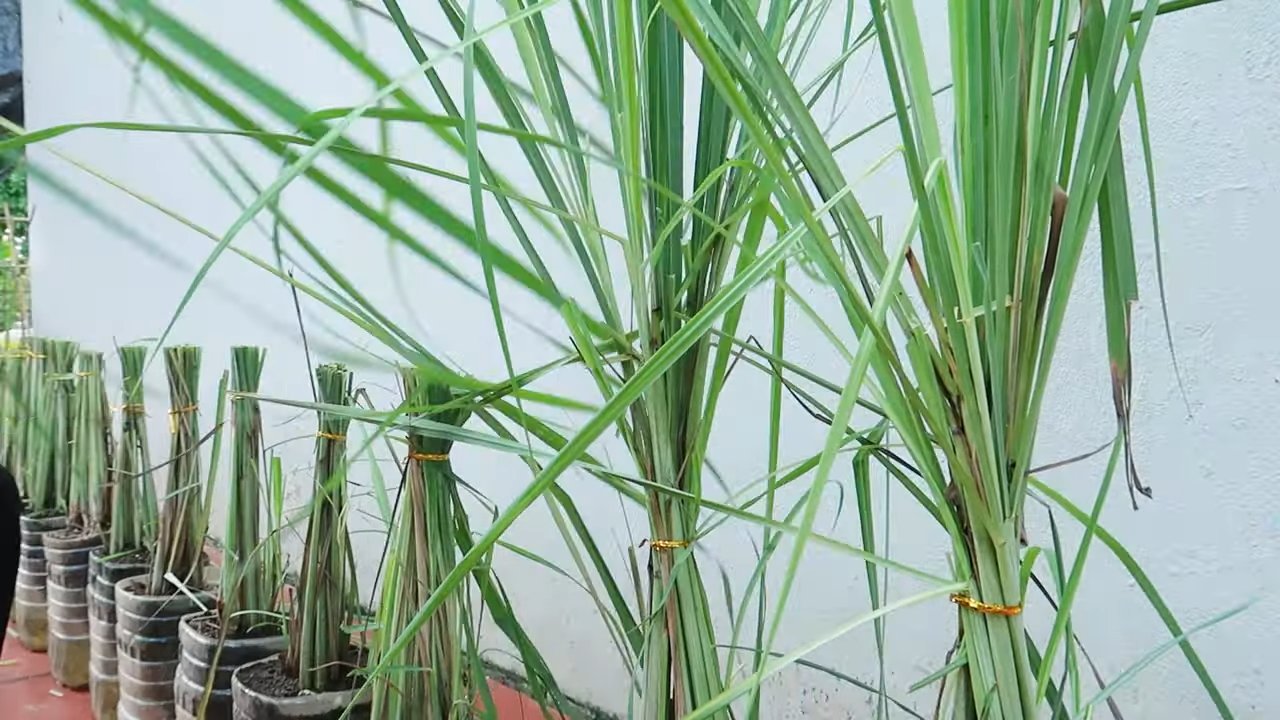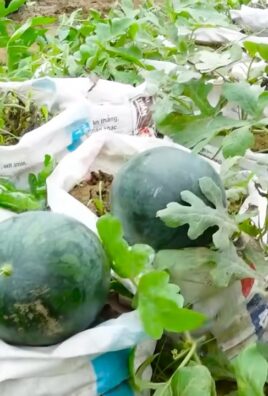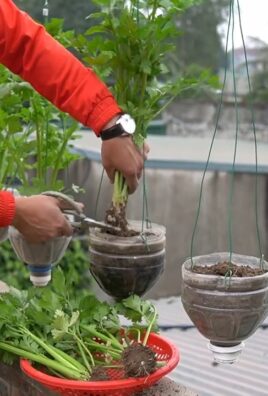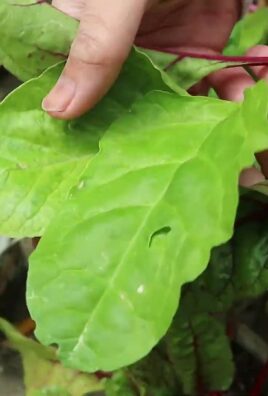Growing lemongrass at home can seem like a tropical dream, especially if you’re yearning for that fresh, citrusy zing in your cooking. But trust me, it’s more achievable than you think! I’m here to show you some simple DIY tricks that will transform your backyard (or even your windowsill!) into a lemongrass haven.
Lemongrass, with its origins rooted in Southeast Asia, has been cherished for centuries, not just for its culinary prowess but also for its medicinal properties. From fragrant teas to flavorful curries, this versatile herb has woven its way into countless cultures. Imagine being able to pluck fresh lemongrass straight from your garden whenever inspiration strikes – no more trips to the grocery store or settling for wilted bunches!
Why should you embark on this DIY adventure? Well, for starters, store-bought lemongrass can be expensive and often lacks the vibrant flavor of freshly grown stalks. Plus, growing lemongrass at home is incredibly rewarding. It’s a sustainable way to add a unique touch to your cooking, create beautiful ornamental plants, and even deter pesky insects. I’m excited to share these easy-to-follow tips and hacks that will have you harvesting your own lemongrass in no time. Let’s get started!

Zitronengras zu Hause anbauen: Ein DIY-Leitfaden für frisches Aroma
Hallo liebe Gartenfreunde! Habt ihr euch jemals gefragt, wie ihr das frische, zitronige Aroma von Zitronengras direkt in eurer Küche haben könnt? Ich zeige euch, wie ihr Zitronengras ganz einfach zu Hause anbauen könnt – egal ob im Garten oder im Topf auf dem Balkon. Es ist einfacher als ihr denkt und bringt einen Hauch von Exotik in eure Gerichte. Los geht’s!
Was ihr für den Zitronengras-Anbau benötigt
Bevor wir loslegen, hier eine Liste der Dinge, die ihr braucht:
* Zitronengras-Stängel: Am besten aus dem Asia-Laden oder gut sortierten Supermarkt. Achtet darauf, dass die Stängel gesund aussehen und noch einen kleinen Wurzelansatz haben.
* Ein Glas Wasser: Für die Bewurzelung.
* Ein Pflanzgefäß oder ein Platz im Garten: Je nachdem, wo ihr euer Zitronengras anbauen möchtet.
* Hochwertige Blumenerde: Zitronengras mag nährstoffreiche Erde.
* Optional: Flüssigdünger: Für zusätzliches Wachstum.
* Eine Gartenschere oder ein scharfes Messer: Zum Kürzen der Blätter.
Zitronengras bewurzeln: Der erste Schritt zum Erfolg
Die Bewurzelung ist der wichtigste Schritt, um sicherzustellen, dass euer Zitronengras auch wirklich wächst. Keine Sorge, es ist kinderleicht!
1. Stängel vorbereiten: Nehmt eure Zitronengras-Stängel und entfernt die äußeren, trockenen Blätter. Achtet darauf, die inneren, frischen Blätter nicht zu beschädigen.
2. Ins Wasser stellen: Füllt euer Glas mit Wasser und stellt die Stängel hinein. Achtet darauf, dass die unteren Enden der Stängel im Wasser sind, aber die Blätter nicht.
3. Standort wählen: Stellt das Glas an einen hellen, warmen Ort, aber nicht in die pralle Sonne. Ein Fensterbrett ist ideal.
4. Wasser wechseln: Wechselt das Wasser alle paar Tage, um Fäulnis zu vermeiden.
5. Wurzeln beobachten: Nach etwa einer Woche solltet ihr die ersten Wurzeln sehen. Lasst die Wurzeln etwa 2-3 cm lang werden, bevor ihr das Zitronengras einpflanzt.
Zitronengras einpflanzen: Ab ins Beet oder in den Topf!
Sobald die Wurzeln ausreichend gewachsen sind, ist es Zeit, das Zitronengras einzupflanzen.
1. Pflanzgefäß vorbereiten: Wählt ein Pflanzgefäß mit ausreichend Platz. Zitronengras kann recht groß werden. Achtet darauf, dass das Gefäß Drainagelöcher hat, damit überschüssiges Wasser ablaufen kann.
2. Erde einfüllen: Füllt das Pflanzgefäß mit hochwertiger Blumenerde. Lasst oben etwa 2-3 cm Platz.
3. Zitronengras einsetzen: Macht ein kleines Loch in die Erde und setzt das Zitronengras vorsichtig hinein. Achtet darauf, die Wurzeln nicht zu beschädigen.
4. Mit Erde bedecken: Füllt das Loch mit Erde auf und drückt sie leicht an.
5. Angießen: Gießt das Zitronengras gründlich an.
Zitronengras im Garten anpflanzen
Wenn ihr einen Garten habt, könnt ihr das Zitronengras auch direkt ins Beet pflanzen.
1. Standort wählen: Zitronengras liebt die Sonne! Wählt einen sonnigen Standort mit gut durchlässigem Boden.
2. Boden vorbereiten: Lockert den Boden auf und entfernt Unkraut. Mischt Kompost oder organischen Dünger unter die Erde, um sie mit Nährstoffen anzureichern.
3. Pflanzloch ausheben: Grabt ein Loch, das etwas größer ist als der Wurzelballen des Zitronengrases.
4. Zitronengras einsetzen: Setzt das Zitronengras vorsichtig in das Loch.
5. Mit Erde bedecken: Füllt das Loch mit Erde auf und drückt sie leicht an.
6. Angießen: Gießt das Zitronengras gründlich an.
Zitronengras pflegen: Damit es prächtig gedeiht
Die richtige Pflege ist entscheidend, damit euer Zitronengras gesund und kräftig wächst.
1. Gießen: Zitronengras mag es feucht, aber nicht nass. Gießt regelmäßig, besonders in den Sommermonaten. Achtet darauf, dass das Wasser gut ablaufen kann, um Staunässe zu vermeiden.
2. Düngen: Düngt das Zitronengras alle paar Wochen mit einem Flüssigdünger. Das fördert das Wachstum und sorgt für kräftige Stängel.
3. Schneiden: Schneidet die Blätter regelmäßig zurück, um das Wachstum anzuregen. Ihr könnt die Blätter auch ernten, um sie in euren Gerichten zu verwenden.
4. Überwintern: Zitronengras ist nicht winterhart. Wenn ihr es im Garten angebaut habt, müsst ihr es vor dem ersten Frost ausgraben und in einen Topf pflanzen. Stellt den Topf an einen hellen, kühlen Ort, z.B. in einen Keller oder eine Garage. Gießt das Zitronengras nur sparsam über den Winter.
Zitronengras ernten: Frische Aromen für eure Küche
Die Ernte ist der Lohn für eure Mühe!
1. Stängel auswählen: Wählt die dicksten und kräftigsten Stängel aus.
2. Schneiden: Schneidet die Stängel mit einer Gartenschere oder einem scharfen Messer knapp über dem Boden ab.
3. Verwenden: Die Stängel können frisch oder getrocknet verwendet werden. Für die Verwendung in Gerichten könnt ihr die Stängel zerdrücken oder fein hacken.
Zitronengras verwenden: Vielseitig und aromatisch
Zitronengras ist ein echter Alleskönner in der Küche. Hier ein paar Ideen, wie ihr es verwenden könnt:
* Suppen und Currys: Zitronengras verleiht Suppen und Currys ein frisches, zitroniges Aroma.
* Tees: Zitronengras-Tee ist erfrischend und beruhigend.
* Marinaden: Zitronengras ist eine tolle Zutat für Marinaden für Fleisch, Fisch und Gemüse.
* Saucen: Zitronengras kann Saucen einen besonderen Pfiff verleihen.
* Desserts: Auch in Desserts, wie z.B. Eis oder Sorbet, kann Zitronengras verwendet werden.
Häufige Probleme und Lösungen
Auch beim Zitronengras-Anbau können mal Probleme auftreten. Hier ein paar Tipps, wie ihr sie lösen könnt:
* Gelbe Blätter: Gelbe Blätter können ein Zeichen für zu viel oder zu wenig Wasser sein. Überprüft die Bodenfeuchtigkeit und passt die Bewässerung entsprechend an.
* Braune Blattspitzen: Braune Blattspitzen können durch trockene Luft verursacht werden. Besprüht die Blätter regelmäßig mit Wasser.
* Schädlinge: Zitronengras ist relativ resistent gegen Schädlinge. Sollten dennoch Schädlinge auftreten, könnt ihr sie mit einem biologischen Schädlingsbekämpfungsmittel bekämpfen.
Zusammenfassung: Zitronengras-Anbau leicht gemacht
Ich hoffe, dieser Leitfaden hat euch gezeigt, wie einfach es ist, Zitronengras zu Hause anzubauen. Mit ein wenig Geduld und Pflege könnt ihr euch schon bald über frisches Zitronengras aus eurem eigenen Garten oder vom Balkon freuen. Viel Spaß beim Gärtnern und Kochen!

Conclusion
So, there you have it! Growing lemongrass at home is not only achievable, but it’s also a rewarding experience that brings a touch of Southeast Asian freshness right to your kitchen. Forget those wilted, overpriced stalks at the grocery store. Imagine stepping into your garden or onto your balcony and snipping off exactly what you need, bursting with vibrant flavor and aroma. This DIY trick is a game-changer for anyone who loves to cook with lemongrass, offering a constant supply of this essential ingredient.
Why is this a must-try? Beyond the convenience and cost savings, growing your own lemongrass allows you to control the quality and freshness. You know exactly where it comes from and how it’s been treated, ensuring you’re using the best possible ingredient in your culinary creations. Plus, the act of nurturing a plant and watching it thrive is incredibly satisfying. It’s a small connection to nature that can brighten your day and enhance your cooking.
But the benefits don’t stop there. Lemongrass is incredibly versatile. Use it in soups, curries, stir-fries, teas, and even cocktails. Infuse it in oils and vinegars for a unique flavor boost. The possibilities are endless!
Ready to take your lemongrass game to the next level? Consider these variations:
* Container Gardening: If you’re short on space, lemongrass thrives in containers. Choose a large pot with good drainage and use a well-draining potting mix. This is perfect for balconies, patios, or even indoor growing with sufficient sunlight.
* Different Varieties: While most lemongrass available commercially is *Cymbopogon citratus*, explore other varieties like *Cymbopogon flexuosus* (East Indian lemongrass) for slightly different flavor profiles.
* Companion Planting: Plant lemongrass alongside other herbs like basil and mint to create a fragrant and productive herb garden. It can also deter certain pests.
* Propagation from Seed: While starting from cuttings is easier, you can also grow lemongrass from seed. Be patient, as germination can be slow.
Don’t be intimidated! Growing lemongrass at home is easier than you might think. With a little sunlight, water, and care, you’ll be harvesting your own fresh lemongrass in no time. We encourage you to give this DIY trick a try. It’s a simple, sustainable, and delicious way to elevate your cooking.
We’re confident that you’ll love the results. And we want to hear about your experience! Share your tips, tricks, and photos with us in the comments below. Let’s build a community of lemongrass growers and inspire others to embrace the joy of homegrown flavor. What are you waiting for? Get planting!
Frequently Asked Questions (FAQ)
What kind of climate is best for growing lemongrass?
Lemongrass thrives in warm climates, ideally USDA zones 9-11. It needs plenty of sunshine (at least 6 hours per day) and well-drained soil. If you live in a colder climate, you can still grow lemongrass in containers and bring them indoors during the winter months. Think of it as a sun-loving plant that appreciates warmth and humidity. If you can provide those conditions, you’re well on your way to successful lemongrass cultivation.
How often should I water my lemongrass plant?
Water your lemongrass regularly, especially during hot and dry periods. The soil should be consistently moist but not waterlogged. Overwatering can lead to root rot, so ensure your pot or garden bed has good drainage. A good rule of thumb is to water when the top inch of soil feels dry to the touch. During the winter months, reduce watering frequency as the plant’s growth slows down.
What kind of soil is best for lemongrass?
Lemongrass prefers well-drained, loamy soil that is rich in organic matter. A slightly acidic to neutral pH (around 6.0 to 7.0) is ideal. If you’re planting in containers, use a high-quality potting mix. You can amend your garden soil with compost or other organic matter to improve drainage and fertility. Avoid heavy clay soils, as they can retain too much moisture and lead to root problems.
How do I harvest lemongrass?
Harvest lemongrass stalks when they are at least 1/2 inch in diameter at the base. Use a sharp knife to cut the stalks close to the ground. You can harvest individual stalks as needed, or you can harvest the entire plant at once. After harvesting, remove the outer, tougher leaves and use the tender inner core for cooking. The outer leaves can be used to make tea or added to compost.
How do I propagate lemongrass?
The easiest way to propagate lemongrass is from cuttings. You can purchase lemongrass stalks from the grocery store (look for stalks with roots attached) or take cuttings from an existing plant. Place the cuttings in a glass of water, making sure the base of the stalks is submerged. Change the water every few days. After a few weeks, roots will begin to develop. Once the roots are a few inches long, you can plant the cuttings in pots or in the garden.
Can I grow lemongrass indoors?
Yes, you can grow lemongrass indoors, but it requires plenty of sunlight. Place your lemongrass plant near a sunny window that receives at least 6 hours of direct sunlight per day. You may also need to supplement with artificial light, especially during the winter months. Ensure the pot has good drainage and water regularly. Indoor-grown lemongrass may not grow as large as outdoor-grown lemongrass, but you can still harvest the leaves for cooking.
What are some common problems when growing lemongrass?
Some common problems when growing lemongrass include root rot (caused by overwatering), pests (such as aphids and spider mites), and nutrient deficiencies. To prevent root rot, ensure your soil has good drainage and avoid overwatering. Inspect your plants regularly for pests and treat them with insecticidal soap or neem oil if necessary. If your lemongrass plant is not growing well, it may be lacking nutrients. Fertilize with a balanced fertilizer according to the package directions.
How do I store lemongrass?
Fresh lemongrass can be stored in the refrigerator for up to two weeks. Wrap the stalks in a damp paper towel and place them in a plastic bag. You can also freeze lemongrass for longer storage. Chop the lemongrass into small pieces and freeze it in an airtight container or freezer bag. Frozen lemongrass can be used directly in cooking without thawing.
Is lemongrass safe for pets?
While lemongrass is generally considered safe for pets in small amounts, it’s best to keep them from consuming large quantities. Some pets may experience digestive upset if they eat too much lemongrass. If you have pets that are prone to chewing on plants, it’s best to keep your lemongrass plant out of their reach.
Can I use lemongrass to make tea?
Yes, lemongrass tea is a delicious and refreshing beverage. To make lemongrass tea, simply steep a few chopped lemongrass stalks in hot water for 5-10 minutes. You can add honey, lemon, or ginger to taste. Lemongrass tea is known for its calming and digestive properties. It’s a great way to enjoy the flavor and benefits of homegrown lemongrass.




Leave a Comment